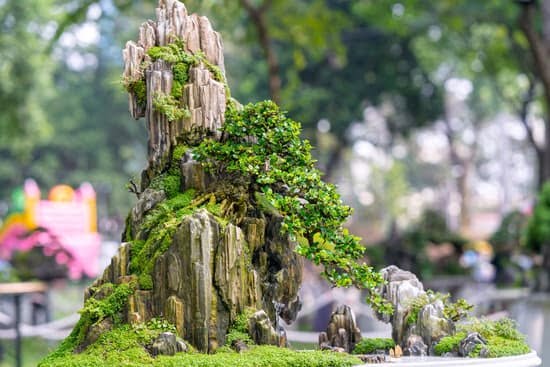Are you looking for ideas for gardens without plants? While traditional gardens are known for their lush greenery and vibrant blooms, a plant-free garden offers a unique and modern alternative that can be just as visually stunning and inviting. In this blog post, we will explore the concept of plant-free gardening, discussing why someone might choose this approach and providing inspiration for creating a beautiful and functional outdoor space without traditional vegetation.
For individuals with limited time for landscaping maintenance or those with allergies to pollen or plants, a garden without plants can offer a low-maintenance and allergen-free option. Additionally, some design aesthetics may simply prefer the clean lines and architectural elements of a plant-free garden.
Whether you have a specific reason for opting for a garden without plants or are simply interested in exploring innovative landscaping ideas, this article will guide you through various elements to consider when designing your own plant-free outdoor space.
From hardscaping ideas to water features, sculptures, art installations, lighting strategies, functional spaces, sustainable design options, and maintenance tips-we will delve into the creative ways you can transform your garden into an oasis without relying on traditional flora. So let’s dive into the world of plant-free gardening and discover the endless possibilities for creating a unique and visually captivating outdoor environment.
Hardscaping Ideas
When it comes to creating a garden without plants, hardscaping becomes the focal point of the design. Hardscaping involves the use of non-living elements such as pathways, patios, and decks to create visually appealing outdoor spaces. One popular idea for gardens without plants is to use different materials like gravel, stone, and wood to add texture and depth to the garden design.
For example, incorporating a gravel pathway can create a sense of charm and whimsy in a plant-free garden. The crunch of gravel underfoot adds a tactile element to the space, while also providing practicality by defining walkways. Additionally, using stone elements such as retaining walls or decorative boulders can add natural beauty and structure to the garden without the need for living plants.
Another idea for hardscaping in plant-free gardens is the use of wooden features such as decks or pergolas. Wood adds warmth and a sense of coziness to an outdoor space, making it an inviting area for relaxation or entertaining. By combining these different hardscaping ideas, individuals can create a diverse and visually engaging garden space without relying on traditional plants.
In addition to these natural materials, there are also creative ways to incorporate man-made elements into a plant-free garden design. This might include using concrete pavers or geometric patterns in walkways and seating areas to add modern flair to the outdoor space. Ultimately, through thoughtful selection and combination of hardscaping materials, a plant-free garden can be transformed into a unique and eye-catching oasis.
| Hardscape Material | Description |
|---|---|
| Gravel | Adds texture and whimsy while enhancing practicality |
| Stone | Provides natural beauty and structure without living plants |
| Wood | Brings warmth and coziness to an outdoor space |
| Concrete Pavers | Adds modern flair through geometric patterns, |
Water Features
In a plant-free garden, water features can be a stunning focal point, adding a sense of tranquility and serenity to the space. There are various options to consider when incorporating water features into your garden design, each with its own unique appeal.
Fountains
Fountains come in a variety of sizes and styles, from small bubbling fountains to large dramatic installations. They can be placed as a standalone feature or integrated into other hardscaping elements for an added visual impact. The sound of running water adds an immersive element to the garden ambiance, creating a peaceful and calming atmosphere.
Ponds and Waterfalls
Ponds and waterfalls bring a touch of nature into your plant-free garden. These features can be designed to fit seamlessly into the landscape, providing a tranquil oasis within the urban environment. Incorporating fish or aquatic plants can further enhance the naturalistic feel, while adding movement and life to the space.
Reflecting Pools
For a more contemporary approach, reflecting pools offer a sleek and modern aesthetic. These shallow pools create mirror-like surfaces that reflect the surrounding architecture and sky, adding depth and dimension to the garden design. With the right lighting, reflecting pools can become mesmerizing focal points during both day and night.
When considering water features for your plant-free garden, it is essential to integrate them harmoniously with other design elements such as lighting, sculptures, and functional spaces. By carefully selecting and positioning water features within your garden, you can create an inviting outdoor retreat that appeals to all the senses.
Sculptures and Art
When it comes to creating a garden without plants, incorporating sculptures and art can be an excellent way to add visual interest and personality to the space. Whether you opt for standalone sculptures, wall art, or interactive installations, there are numerous ways to incorporate art into your plant-free garden design. Sculptures and art can serve as focal points, conversation starters, and even functional elements within the garden.
One popular idea for incorporating art into a plant-free garden is to use sculptures as focal points. Whether it’s a striking metal sculpture, a whimsical stone carving, or a modern abstract piece, sculptures can provide visual interest and draw the eye within the landscape. Placing sculptures strategically throughout the garden can create a sense of discovery and surprise as visitors explore the space.
In addition to standalone sculptures, consider using wall art or other types of installations to adorn hardscaping elements such as fences, retaining walls, or outdoor structures. This can add an unexpected element to the garden design while also allowing you to express your personal style. Furthermore, interactive art installations such as kinetic pieces or sound sculptures can engage visitors on a multisensory level, adding an extra layer of intrigue to your plant-free garden design.
| Art Ideas | Description |
|---|---|
| Standalone Sculptures | Strategically place unique sculpture pieces throughout the garden. |
| Wall Art Installations | Adorn hardscaping elements with wall art or other installations. |
| Interactive Art Pieces | Create engaging experiences with kinetic or sound-driven artworks. |
Lighting Strategies
When it comes to creating a visually appealing and inviting garden space without plants, one key element to consider is strategic lighting. By incorporating different types of lighting, you can enhance the ambiance of your plant-free garden and create a welcoming atmosphere for both daytime and nighttime enjoyment.
Types of Lighting
One idea for illuminating your plant-free garden is to incorporate string lights along pathways or around hardscaping elements. These gentle, warm lights can add a cozy and inviting feel to the space, especially in the evening hours. Additionally, lanterns placed strategically throughout the garden can provide both functional lighting and decorative accents.
Another option to consider is the use of spotlights to highlight specific features of your garden, such as sculptures or art installations. By focusing light on these elements, you can create focal points and draw attention to the unique design aspects of your plant-free outdoor space.
Creating Ambiance
Strategic lighting in a plant-free garden can also help create a sense of ambiance. For example, soft white lights placed near water features such as fountains or ponds can enhance the tranquility and serenity of these elements, making them even more enjoyable to experience.
In addition to enhancing the aesthetics of your garden, thoughtfully placed lighting can also provide safety and visibility for outdoor gatherings or activities. By carefully considering how different types of lighting contribute to the overall ambiance of your plant-free garden space, you can ensure that it remains welcoming and enjoyable at all times.
Functional Spaces
Creating functional spaces in a plant-free garden is essential for ensuring that the outdoor area is not only visually appealing but also practical and enjoyable for gatherings and relaxation. Here are some ideas for designing functional spaces in a garden without plants:
- Outdoor Kitchen: Consider incorporating an outdoor kitchen into the design of your plant-free garden. This can include a built-in grill, countertops, and storage space for cooking utensils. A well-designed outdoor kitchen can serve as a focal point for entertaining guests and enjoying al fresco dining.
- Seating Areas: Designate different seating areas throughout the garden to provide comfortable spots for relaxation and socialization. This can include cozy conversation nooks with comfortable seating, as well as larger dining areas with tables and chairs. Consider using weather-resistant materials like rattan or metal to ensure durability.
- Fire Pit: Adding a fire pit to your plant-free garden can create a warm and inviting ambiance, especially during cooler evenings. Choose from various styles of fire pits, such as wood-burning or gas-powered, and surround the area with comfortable seating options for gathering around the fire.
By carefully planning and designing these functional spaces, you can transform your plant-free garden into a versatile outdoor oasis that meets all your entertainment and relaxation needs.
Sustainable Design
When it comes to creating a garden without plants, sustainability is a key factor to consider. Incorporating eco-friendly and sustainable design elements can not only benefit the environment but also contribute to the overall aesthetic of the space. Here are some ideas for sustainable design in a plant-free garden:
- Use of recycled materials: Utilizing recycled materials such as reclaimed wood, composite decking, and repurposed stone can reduce the environmental impact of construction while adding character to the garden.
- Energy-efficient lighting: Opting for LED or solar-powered lighting options can minimize energy consumption and lower utility costs, all while illuminating the garden space effectively.
- Water conservation techniques: Implementing rainwater harvesting systems, water-efficient fountains, and drip irrigation can help minimize water usage and promote sustainable practices within the garden.
Incorporating these sustainable design strategies can not only create an environmentally friendly garden but also showcase a commitment to responsible stewardship of natural resources.
Maintaining a plant-free garden with sustainable design elements requires attention to detail and regular upkeep. However, by utilizing these eco-friendly practices, you can enjoy a beautiful and functional outdoor space while minimizing its impact on the environment.
Maintenance Tips
In conclusion, creating a garden without plants can open up a world of possibilities for designing a unique and visually striking outdoor space. By focusing on hardscaping elements, water features, art installations, lighting strategies, functional spaces, and sustainable design, individuals can create a garden that is both practical and aesthetically pleasing. Whether for personal enjoyment or as a statement piece in landscape design, the ideas for gardens without plants offer endless opportunities for creativity and innovation.
Furthermore, maintaining a plant-free garden requires special attention to preserving the integrity of hardscaping elements, caring for water features, and keeping art installations in top condition. By following maintenance tips such as regular cleaning of hardscaping surfaces and implementing sustainable design practices like energy-efficient lighting and water conservation techniques, individuals can ensure that their plant-free garden remains a captivating and inviting space for years to come.
In summary, the concept of gardens without plants provides an alternative approach to traditional landscape design. With thoughtful consideration of hardscaping, water features, art installations, lighting strategies, functional spaces, sustainability practices, and maintenance tips, individuals can bring their vision of a plant-free garden to life. Whether seeking tranquility or making a bold design statement in outdoor spaces, the ideas for gardens without plants present endless opportunities for creating stunning and distinctive landscapes.
Frequently Asked Questions
How Do You Make a Garden Without Plants?
Creating a garden without plants might seem contradictory, but it can be achieved by focusing on non-living elements such as pathways, rocks, sculptures, and water features. These elements can still create a visually appealing outdoor space.
How Do You Decorate an Outdoor Planter Without Plants?
When decorating an outdoor planter without plants, consider using materials like colored stones or pebbles, decorative mulch, or even arranging driftwood or interesting branches. These non-plant elements can still add visual interest to your outdoor space.
How Do I Add a Curb Appeal Without Plants?
Adding curb appeal without plants can be done by focusing on other aspects of your home’s exterior. This could include updating the front door with a fresh coat of paint, adding new house numbers or lighting fixtures, or even installing window boxes or shutters to enhance the overall look of your home’s facade.

Welcome to my gardening blog! I am passionate about plants and enjoy sharing my knowledge and experiences with others. In this blog, I will write about everything related to gardening, from tips on how to get started to updates on my own garden projects.





